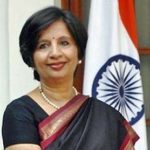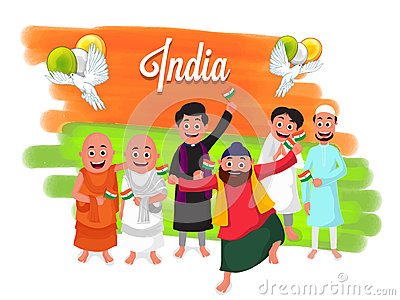
“We are a blended nation. Our long traditions, our languages, our home states, these cultural geographies have blurred and indistinct boundaries, interrelated contexts of meaning. There are many echoes, spirits and voices that inhabit our gardens. Separation and distinctiveness are not their defining features. Human life is not about separation but about connection”, says the author – Nirupama Rao.
I am a Hindu by birth and by enduring faith. The house that I was born into that my grandfather built, had no special puja room — but the plaster of Paris statue of a flute playing Krishna, the Ravi Varma oleographs of a Lakshmi rising from a lotus with elephants trumpeting their joy at her presence, the veena-playing Saraswati, and our special deity Lord Guruvayurappan, with beautiful Kartikeya and his “vel”(spear) and his vehicle, the peacock made up the pantheon of our isthtadevatas.
On my trips to my “native place” as we say in Indian English, I remember how every evening, the vilakku (bronze lamp) was lit with cotton wicks we lovingly made, dipped in gingelly oil, and brought out to the verandah of the tharawad (Hindu matrilineal family) house, with the heralding word: “Deepam” (lamp) repeated two or three times, quietly, with deep reverence. We would greet the sight of this burnished lamp and its brave, bright flame in a prayerful namaskar with bowed heads in a moment of blessed quietude, as imaginary and heavenly angels murmured in the dusk of a tropical Kerala garden around us.
Wherever we lived as children travelling the length and breadth of India with my army officer father, my homemaker mother would gather us three sisters together at dusk to say our prayers after she had lit the little vilakku that graced a small corner of the bedroom, auspiciously positioned.
We sat down cross-legged on the bare floor, put our hands together in prayer, and recited our Om Namashivaya, and sang a few bhajans including Gandhiji’s favourite “Raghupati Raghava”. We must have sung with youthful fervour and reasonable harmony because in one of the towns we lived in, the neighbouring Malayalee Catholic family with whom we shared a wall, the Pereiras, would listen tell my mother how much they loved our “evensong”. Them being Christian, and our being Hindu did not matter in those simple days.
I went to Catholic school till I finished high school and to a Catholic undergraduate college after that. I read Bible history as a young girl and was equally fascinated with the stories of Moses, N the Ark of Noah, and the life of Jesus as I was with the Ramayana and the Mahabharata. Growing up, we were taught to respect all faiths and to be tolerant of differences. We grew into self-confident Hindus, secure in our faith and respectful of our Christian and Muslim classmates and friends.
In this recalling of memory, I am reminded of the saying that “the past is another country”. Where is that far-off land? What starship are we voyaging on today? Today we Hindus demand “empathy” from the minorities in our country. A Muslim dairy farmer transporting a cow, even with a permit, is not showing empathy for the majority religion, an NRI friend said recently. India is a Hindu nation he added and the minorities should respectfully acknowledge this and adjust to this basic reality.
Ensconced in the United States, I do not believe he had any doubt in his mind that Hinduism should constitutionally be India’s national religion. Having lived in Sri Lanka, I was reminded of the manner in which that island country made Buddhism its state religion, with its Buddhist clergy being the most powerful source of authority in the land, and all the momentous repercussions of that approach for civil society and the Sri Lankan minorities.
Is India a wounded civilization? If our religion as Hindus has survived intact despite the depredations of conquest and empire over the last millennium, then are we not prepared to face the next with the steadfastness of faith and the confidence that Hinduism with its capacity for tolerance and accommodation can create the India of our dreams? Are we instead, intent on molding our lives on the basis of religious militancy and a fundamentalist interpretation of belief? Are we intent on the subjugation of our religious minorities so that they conform to what our idea of their place in our society should be?
Pepita Seth, the English woman who has become a Hindu, and made Kerala and particularly Guruvayur her home, has a passage in her book, Heaven on Earth: The Universe of Kerala’s Guruvayur Temple, that eloquently sums up how I define my being Hindu:
“In northern Malabar there is a Theyyam deity, Kshetrapalan, the guardian of temples, who once demolished a semi-ruined shrine and built a mosque to give a growing community of Muslims a place of worship. This, in essence is a sharing of cultures and spaces, even as the other is respected. This fineness shows India’s profoundly pluralistic dimension. It is beyond me to suggest what can be done, political will being what it is. The great hope is that our children can, at an early age, be shown what is common to us all, that with opened minds they come to recognize that this will give them a share of the wider whole. As India is railed against for the dreadful things that now too often happen, it can help to recognize that the other side of the coin exists. And that I have been lucky to experience it.”
India’s is a map of many migrations. She speaks to both East and West, those twins of history, when she demonstrates the fact that labels like Hindu, Muslim, Christian are no more than starting points. We are a blended nation. Our long traditions, our languages, our home states, these cultural geographies have blurred and indistinct boundaries, interrelated contexts of meaning. There are many echoes, spirits and voices that inhabit our gardens. Separation and distinctiveness are not their defining features. Human life is not about separation but about connection.
Gandhiji drew inspiration from the devotional traditions of Hindu faith as expressed in the ideals of the religious poets and preachers of rural Gujarat, as also from Thoreau and Tolstoy, and even Christianity. He wove these influences into his life and made them work in a manner that was magnetic, riveting and resoundingly powerful. There is power in his example. The Indian answer to the question “who am I” which is “I am that” or Tat Tvam Asi, signifies a oneness with all creation. The Chinese saying: There is me in you, and you in me bridges divisions of race or creed. The Sanskrit word, Viswabodh or, awareness of the whole world, should apply in everything we do.
It was Rabindranath Tagore who, when he spoke of the idea of India, which as he emphasised was not just a geographical expression, (“I love my India, but my India is an idea and not a geographical expression”), stressed the assimilative outlook, the irreducible diversity that characterised the civilization of India. In a similar way, life in my home state of Kerala has been largely marked by the tenor of coexistence between Hindus, Muslims and Christians. Each community left the other to come to terms with his God in his or her own fashion and in the words of the writer Krishna Chaitanya, realising that difference here in no way militated against close cooperation in activities that ensured the livelihood of all.
The great twentieth century poet in Malayalam, Vallathol, a Hindu, wrote a narrative poem on Mary Magdalene which is treasured by the Christian community both for its spiritual high notes as well as its sheer beauty. The story of Genesis is seen integrated with the Hindu myth of origin of the churning of the primeval ocean by the gods and demons. This is the true symbiosis that India should seek to treasure and to preserve.
Today, at evensong, even as I celebrate my being Hindu, I pray for India. I pray for peaceful coexistence, and for us to conduct our lives as citizens of a great and grown-up nation. Let us not leave our destinies to the vagaries of fate, or the tyranny of the closed and confined mind.
(The author is a former Foreign Secretary of India) (Source: First Post) British English
